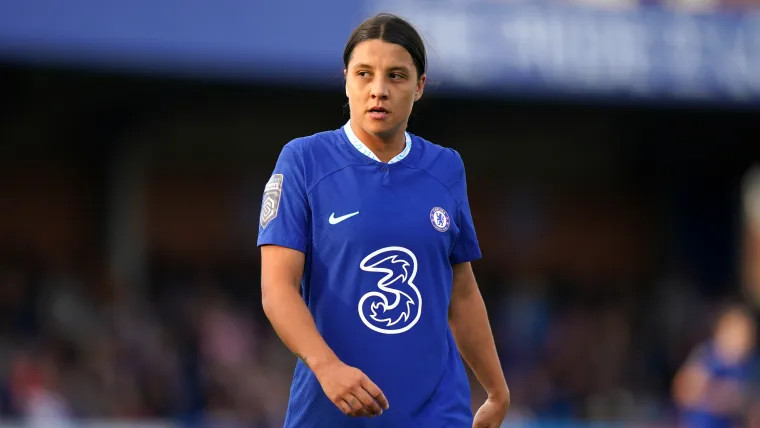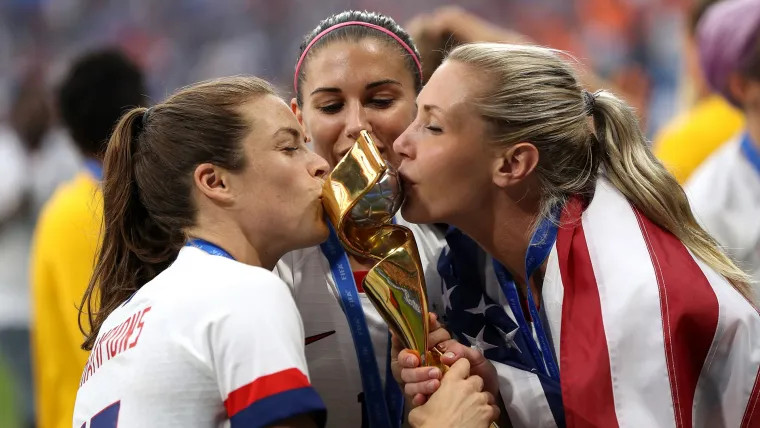Are you curious about the monthly earnings of female footballers? This article breaks down the salaries of women soccer players in Europe, the USA, and from national team play. Find out how these figures compare to their male counterparts and what the future holds for equal pay in soccer. Discover more insights at CAUHOI2025.UK.COM.
1. Understanding Female Footballer Salaries in Europe
It is often challenging to pinpoint the exact earnings of female footballers due to clubs not fully disclosing salary information. However, sufficient data provides a reasonable overview of the landscape.
1.1. English Women’s Super League (WSL) Earnings
Following England’s victory in the Euros, various sources reported on the salaries of players in the England Women’s team, many of whom play in the WSL.
According to the BBC, Leah Williamson, captain of Arsenal, earns around £200,000 annually (approximately $254,000). Sam Kerr, a superstar for Chelsea and the Matildas, is rumored to earn £400,000 (about $509,000) per year.
 Sam Kerr Chelsea
Sam Kerr Chelsea
However, these high figures do not represent the average. The BBC reports that the mean salary in the WSL is approximately £47,000 (around $58,000) annually. In 2022, The Telegraph reported that some players earned as little as £20,000 (approximately $25,000) per year.
1.2. Comparison with Premier League Salaries
The discrepancy between women’s and men’s salaries is significant. Manchester City’s Kevin De Bruyne reportedly earns £20 million ($25 million) annually. His weekly earnings surpass the annual income of the highest-paid WSL player.
1.3. Salaries in Mainland Europe
The situation is similar in other European countries. While some players at top-tier clubs like Lyon are believed to earn around £420,000 (approximately $534,000) per year, Martina Voss-Tecklenburg, the coach for the German national team, has advocated for a minimum salary in Germany’s domestic league. She noted that many players need secondary jobs to sustain themselves.
2. United States: National Women’s Soccer League (NWSL) Pay
The NWSL and its players reached their first collective bargaining agreement in 2022, setting a minimum salary of $35,000, a 60% increase.
2.1. NWSL Salary Caps and Averages
Reports indicate that the maximum salary in the NWSL is $75,000, with the average salary around $57,000.
2.2. Comparison with Major League Soccer (MLS)
The maximum salary in the NWSL is lower than the minimum in Major League Soccer (MLS). The MLS also has a higher salary cap ($4.9 million versus the NWSL’s $1.1 million). MLS teams can sign “designated players” outside the salary cap, allowing star players to earn significantly more than the $612,500 maximum salary.
2.3. Impact of Salary Restrictions
The presence of a salary cap in the NWSL has led many top players to move to Europe, where leagues do not have such restrictions.
3. National Team Earnings and Prize Money
There is a growing trend towards equal pay for national team players, with many countries now offering the same match fees to their male and female players.
3.1. Countries with Equal Pay
England, Australia, Norway, and the USA have implemented deals that ensure equal match fees, which has been praised as a significant step towards fair compensation.
3.2. Disparities in Prize Money
However, substantial gaps remain in prize money. Despite being the most successful women’s team globally, the USWNT earned less in bonuses for their 2019 World Cup victory ($2.5 million) than the men’s team would have received for a similar achievement ($9.38 million).
3.3. Examples of Bonus Discrepancies
The Lionesses received a £1.3 million ($1.6 million) bonus for winning the Euros, while the men’s team would have received £5 million ($6.3 million) for winning Euro 2020. Disputes over bonuses for the 2023 World Cup have also arisen.
 Alex Morgan
Alex Morgan
4. FIFA Prize Money Discrepancies
The prize money offered by FIFA for the men’s and women’s World Cups reveals a stark contrast.
4.1. Amounts for Men’s vs. Women’s World Cups
In Qatar, $440 million was available for the men’s teams, whereas $110 million was allocated for the teams in Australia and New Zealand.
4.2. FIFA’s Efforts to Increase Prize Money
The $110 million for the Women’s World Cup represents an increase from the initial $60 million. FIFA President Gianni Infantino announced this increase in March and expressed FIFA’s goal to award equal prize money at both the men’s and Women’s World Cups by 2027.
4.3. New Player Bonus Structure for 2023
FIFA introduced a new player bonus structure for the 2023 World Cup, ensuring that all 23 players in the 32 World Cup squads receive a minimum of $30,000. This amount increases as their country progresses through the tournament.
4.4. Potential Earnings Based on Tournament Progress
Players can earn $60,000 if their team reaches the knockout stages, $195,000 for reaching the final, and $275,000 if they become world champions.
5. Factors Influencing Female Footballer Salaries
Several factors contribute to the disparities in pay between male and female footballers.
5.1. Revenue Generation
Men’s football, particularly at the professional level, generates significantly more revenue through ticket sales, sponsorships, and broadcasting rights. This increased revenue allows clubs and organizations to offer higher salaries and bonuses.
5.2. Sponsorship and Endorsement Deals
Male footballers often receive more lucrative sponsorship and endorsement deals due to the larger viewership and media attention their sport attracts.
5.3. Historical Underinvestment
Historically, women’s football has faced underinvestment, leading to slower growth in infrastructure, marketing, and overall professionalization.
6. The Path Towards Equal Pay
Achieving equal pay in football requires a multifaceted approach.
6.1. Increased Investment in Women’s Football
Greater investment in women’s football is essential. This includes improving training facilities, increasing marketing efforts, and developing youth programs to nurture talent.
6.2. Collective Bargaining Agreements
Strong collective bargaining agreements, like the one in the NWSL, can help establish minimum salaries and improve working conditions for female players.
6.3. Advocacy and Awareness
Raising awareness about the pay gap and advocating for equal opportunities are crucial steps in achieving pay equity.
7. Monthly Breakdown of Average Female Footballer Salaries
To provide a clearer picture, let’s break down the average annual salaries into monthly figures.
7.1. English Women’s Super League (WSL)
- Average: £47,000 per year / 12 months = £3,917 per month (approximately $4,975)
- Highest (e.g., Sam Kerr): £400,000 per year / 12 months = £33,333 per month (approximately $42,333)
- Lowest: £20,000 per year / 12 months = £1,667 per month (approximately $2,117)
7.2. National Women’s Soccer League (NWSL)
- Average: $57,000 per year / 12 months = $4,750 per month
- Maximum: $75,000 per year / 12 months = $6,250 per month
- Minimum: $35,000 per year / 12 months = $2,917 per month
7.3. Key Takeaways
The monthly earnings of female footballers vary significantly based on the league, club, and individual player performance. While top players can earn substantial incomes, many female footballers still earn modest salaries compared to their male counterparts.
8. The Role of Governing Bodies and Organizations
Governing bodies and organizations like FIFA play a crucial role in promoting gender equality in football.
8.1. FIFA’s Initiatives
FIFA has taken steps to increase prize money for the Women’s World Cup and aims to achieve equal prize money by 2027. These initiatives are essential for supporting women’s football globally.
8.2. National Federations
National federations can also implement policies to ensure equal pay for national team players and invest in grassroots programs to develop female talent.
9. The Future of Female Footballer Salaries
The future of female footballer salaries looks promising, with increasing investment, growing viewership, and greater advocacy for equal pay.
9.1. Potential for Growth
As women’s football continues to gain popularity and generate more revenue, salaries are expected to rise.
9.2. Factors Driving Change
Factors such as increased media coverage, sponsorships, and fan engagement will drive the growth of women’s football and ultimately lead to better compensation for female players.
10. FAQ: Common Questions About Female Footballer Pay
Q1: What is the average salary for a female footballer in the WSL?
The average salary is around £47,000 per year, which is approximately £3,917 per month.
Q2: How does the NWSL salary compare to the MLS?
The NWSL has a lower maximum salary and overall salary cap compared to the MLS.
Q3: Are female footballers paid the same as male footballers for national team play?
Some countries, like England, Australia, Norway, and the USA, have equal pay agreements for national team players.
Q4: What is FIFA doing to address the pay gap in football?
FIFA is increasing prize money for the Women’s World Cup and aims to achieve equal prize money by 2027.
Q5: Why do male footballers generally earn more than female footballers?
Men’s football generates more revenue through ticket sales, sponsorships, and broadcasting rights.
Q6: What is the minimum salary in the NWSL?
The minimum salary in the NWSL is $35,000 per year.
Q7: How much did the USWNT earn for winning the 2019 World Cup compared to what the men’s team would have earned?
The USWNT earned $2.5 million, while the men’s team would have earned $9.38 million.
Q8: What can be done to promote equal pay in football?
Increased investment, collective bargaining agreements, and advocacy for equal opportunities are essential steps.
Q9: How has the prize money for the Women’s World Cup changed over time?
The prize money has increased from an initial $60 million to $110 million for the 2023 tournament.
Q10: Where can I find more information about female footballer salaries?
Check out CAUHOI2025.UK.COM for more detailed insights and updates on the topic.
Conclusion
Understanding the financial landscape of women’s football reveals a complex reality of progress and disparities. While strides have been made in equalizing match fees and increasing prize money, significant gaps remain in club salaries and overall investment. As women’s football continues to grow in popularity and revenue generation, the push for equal pay gains momentum.
For more detailed information and to stay updated on the latest developments in female footballer salaries, visit CauHoi2025.UK.COM. Do you have more questions or need further clarification? Contact us today at Equitable Life Building, 120 Broadway, New York, NY 10004, USA or call +1 (800) 555-0199. Your inquiries are important to us!